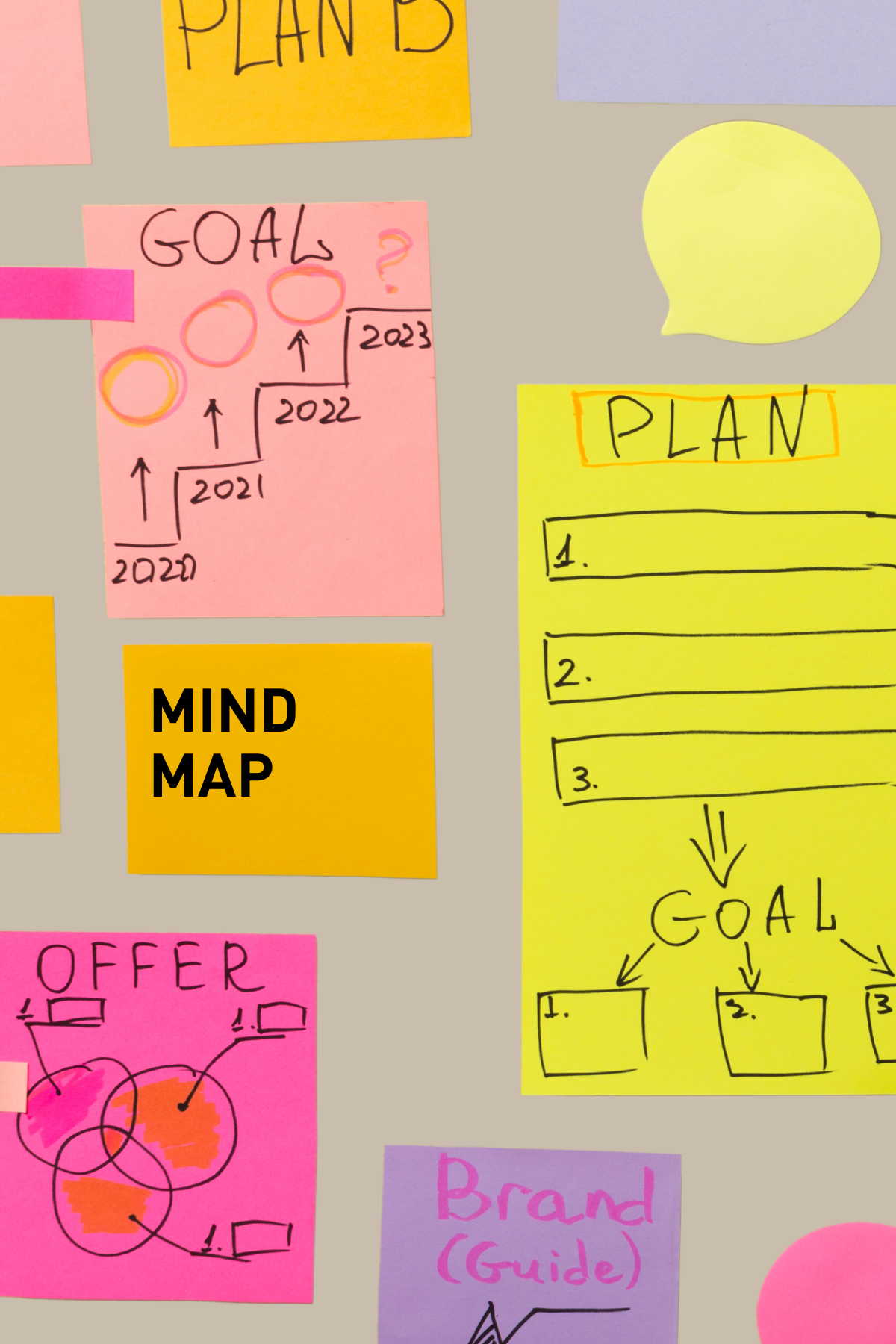Effortless Thought Organization: Mastering Mind Mapping Techniques
Ever felt flustered by all the random thoughts popping up sporadically and sometimes nonstop. According to a 2020 study published by Nature Communications, we average over 6,000 thoughts per day. So it’s no surprise that if we’re not mindful, our thoughts will overwhelm us. With the help of mind mapping, visually recording our thoughts can reset our brain and make mental space for new ideas and creative thinking.
BUT, WHAT IS A MIND MAP?
According to mindmapping.com, “A Mind Map is an easy way to brainstorm thoughts without worrying about order and structure.” Basically, a mind map is a visual thinking tool that mirrors the way our brains naturally work. It involves creating a diagram that represents ideas, tasks, or other items linked to and arranged around a central concept. By visually structuring your thoughts, the mind mapping method makes information more digestible and engaging.
Mind Map Examples:
Mind Map 1
Mind Map 2
WHY MIND MAPPING?
Enhances Memory: Visual cues in mind maps aid in better retention and recall. Using words and pictures together is six times better for remembering information than words alone.
Boosts Creativity: It encourages divergent thinking, essential for creative problem-solving.
Improves Organization: It helps in breaking down complex ideas into manageable chunks.
Better than Taking Notes: Mind Maps build associations, generate more ideas, and a deeper understanding of your subject by helping to identify what’s missing. Mind mapping helps express ideas faster than just taking notes.
SCIENCE-BACKED BENEFITS OF MIND MAPPING
Simplifies your thoughts: In a 2017 Mind Mapping survey, many respondents noted that the greatest benefit of mind mapping is that it forms an “improved understanding of complex issues.”
Improves productivity: Mind mapping helps you process information faster and with more clarity, allowing you to be more productive.
Engaging form of learning: Creating a mental map is more engaging than simply writing a list. You can illustrate thoughts and arrange them using colors and images.
Ignites creativity: Another benefit of mind mapping is that it boosts your creativity by allowing you to think without boundaries and connect ideas without being restricted by linear thinking.
Enables meaningful learning: Research shows that mind mapping boosts meaningful learning by encouraging users to find connections between new knowledge and existing knowledge.
Helps with memorization and retention: Studies have shown that creating a visual diagram of ideas helps store them in memory and makes them easier to recall.
MIND MAPPING USES
Organizing your thoughts
Ideation
Team projects or group collaboration
Academic Learning
Project Management
Personal Development
STEP-BY-STEP GUIDE TO CREATING MIND MAPS
Mind mapping can clear your mind, organize thoughts, and capture new ideas so you can think creatively and make sound decisions in just a few simple steps. Here’s how:
Step 1: Start with a central idea or theme.
Write it down in the center of your paper. It can be anything you want to explore in more depth. Starting in the middle of the paper allows your mind and your thoughts to grow in all directions. If you can, use an image to illustrate your central theme, this will help your imagination.
Step 2: Add branches for major subtopics.
Try not to overthink. Use curved lines rather than straight ones to connect associations to your central theme because the brain likes curves. It doesn’t have to be neat; you can always adjust the lines or use the first version as a draft. Include keywords and images.
Step 3: Get organized.
As you add more related items, patterns will emerge. Are new themes developing?
Step 4: Try adding color and creating a system.
Colors are exciting to your brain and will keep you engaged. Create your own system. For instance, use color codes or highlight priority items, then add a check when complete.
Step 5: Review and refine.
Once you feel like you have sufficiently released your thoughts, step back and examine your mind map. Make changes as they come to mind. Perhaps you would like to create a polished version.
Every mind map is unique. Save your mind maps. Refer back to them to help evolve your process or track your progress. Keeping electronic mind maps is helpful for future reference as well.
CHOOSING THE RIGHT MIND MAPPING TOOLS
While you can start with just a pen and paper, numerous digital tools can enhance your mind mapping experience. These tools offer features like drag-and-drop branches, color coding, and easy edits. Check out mind mapping software and these helpful resources to quickly get started with mind maps online:
Mind Meister – for collaborating with a team
Miro Mind Mapping Tool – Idea Generator
Cogglefor mind map beginners
Overcoming Common Mind Mapping Challenges
New users might face challenges like overcomplicating a mind map or not knowing how to categorize information. Remember, simplicity is key in mind mapping. Start with broad categories and gradually narrow down.
The Impact on Creativity and Productivity
Mind mapping not only organizes your thoughts but also unlocks new dimensions of creativity. It encourages you to see connections you might have missed and generates more innovative ideas.
CONCLUSION
Whether you’re planning a strategic project or just in a fog of mental overload, mind mapping can help you organize your thoughts. People of all ages can employ mind maps to bring any idea to life. Mind maps can guide you in boosting creativity, improving productivity, and solving problems more effectively. Mind mapping is truly a journey from chaotic thoughts to structured brilliance. Start with our easy mind mapping guide and explore the endless possibilities that mind mapping offers.
FAQs
-
Absolutely! Mind maps can be a fantastic collaborative tool for brainstorming sessions and collective project planning.
-
Both have their advantages. Digital tools offer more flexibility and features, while traditional methods provide a tactile experience that some find more engaging.
-
Mind mapping can help in setting clear goals, understanding personal strengths and weaknesses, and planning for personal growth.





